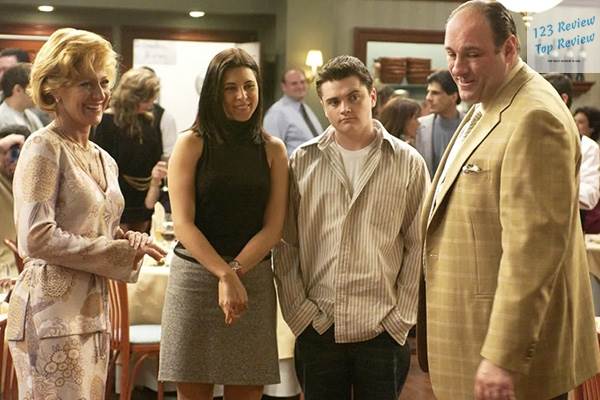In this article, 123 Review explores the intricate narrative, complex characters, and profound themes that made “The Sopranos” a cultural phenomenon. From Tony Soprano’s struggle to balance his family life with his role as a mob boss, to the show’s impact on the portrayal of anti-heroes in media, we examine how “The Sopranos” set new standards for storytelling and character development in the entertainment industry. Whether you’re a long-time fan or new to the series, this article offers a comprehensive look at why “The Sopranos” remains a timeless classic.
1. Overview of The Sopranos
The Impact on Television History
“The Sopranos,” which premiered in 1999 on HBO, is widely regarded as one of the most groundbreaking television series ever created. By blending cinematic production values with complex, serialized storytelling, the show set a new standard for television dramas. It played a pivotal role in establishing the era known as the Golden Age of Television, influencing numerous subsequent series with its innovative approach to narrative and character development. Its success demonstrated that television could offer the same depth and quality as cinema, forever changing the landscape of TV programming.

Cultural References and Significance
From its debut, “The Sopranos” permeated popular culture, becoming a touchstone referenced across various media. The show’s portrayal of the mafia, combined with its exploration of American life, resonated with audiences and creators alike. Its influence can be seen in countless parodies, homages, and discussions about the intersection of organized crime and family dynamics. The show’s impact extends beyond entertainment, prompting discussions about its themes and characters in academic and social contexts.
Awards and Acclaim
“The Sopranos” garnered critical acclaim and a plethora of awards throughout its run, including 21 Primetime Emmy Awards and five Golden Globe Awards. The series’ innovative storytelling, exceptional acting, and high production quality were frequently lauded by critics and audiences. These accolades helped solidify its status as one of the greatest television series of all time, a benchmark against which future shows would be measured.
Behind the Scenes: Creation and Development
The creative force behind “The Sopranos” was David Chase, who drew inspiration from his own experiences and the cultural milieu of New Jersey. The development process involved a meticulous approach to character and story, ensuring a rich and multi-layered narrative. Chase’s vision, combined with the talents of writers, directors, and actors, brought to life a world that was both grounded and expansive. The show’s development included careful casting, location scouting, and scriptwriting, all contributing to its authenticity and depth.
2. Character Analysis
Tony Soprano: A Complex Antihero
Tony Soprano, portrayed by James Gandolfini, is one of television’s most complex characters. As a mafia boss struggling with anxiety and depression, Tony is an antihero who challenges viewers’ perceptions of morality and leadership. His character is multifaceted, balancing ruthless criminal activities with moments of vulnerability and introspection. Tony’s therapy sessions with Dr. Melfi provide insight into his psyche, revealing his internal conflicts and deep-seated issues.
Carmela Soprano: The Struggles of a Mob Wife
Carmela Soprano, played by Edie Falco, represents the emotional and moral struggles of being married to a mob boss. Her character navigates a complex web of loyalty, love, and personal integrity. Throughout the series, Carmela grapples with the ethical implications of her husband’s lifestyle and her own complicity. Her journey reflects the broader themes of power, control, and the sacrifices made for family.
Supporting Characters: Friends and Foes
The supporting characters in “The Sopranos,” including Christopher Moltisanti, Paulie Gualtieri, and Dr. Jennifer Melfi, each bring unique dimensions to the story. Christopher, Tony’s protégé, deals with addiction and ambition; Paulie provides comic relief and insight into the old-school mafia mentality; Dr. Melfi offers a window into Tony’s mind and the therapeutic process. Each character’s subplot enriches the main narrative, providing a diverse array of perspectives on life within the mafia.
Character Growth Throughout the Series
Over the course of six seasons, the characters in “The Sopranos” undergo significant development. Their growth, regressions, and ultimate fates reflect the show’s themes of change, consequence, and the human condition. Tony’s evolution from a troubled mob boss to a more introspective individual, Carmela’s quest for self-worth, and Christopher’s struggle with addiction highlight the dynamic nature of the series’ character arcs.
3. Themes and Motifs
Family Dynamics in Organized Crime
“The Sopranos” delves deeply into the complexities of family relationships within the context of organized crime. It examines loyalty, betrayal, and the conflicting demands of familial and criminal responsibilities. The series portrays the Sopranos’ family as both a traditional nuclear family and a criminal enterprise, blurring the lines between personal and professional life.
Mental Health and Therapy
A central theme in “The Sopranos” is mental health, explored primarily through Tony’s sessions with Dr. Melfi. The series addresses the stigmas associated with therapy, particularly within the macho world of the mafia. Tony’s mental health struggles and his efforts to address them provide a unique perspective on the challenges of seeking help while living a life of violence and crime.
Morality and Ethics within the Mafia
The show raises profound questions about morality and ethics, depicting the often-blurred lines between right and wrong in the mafia world. Characters frequently grapple with the moral implications of their actions, highlighting the complex interplay between personal values and the demands of their criminal activities.
The American Dream: Pursuit and Consequences
“The Sopranos” critically examines the pursuit of the American Dream, showcasing the characters’ desires for success, power, and happiness. It explores the often-destructive consequences of these pursuits, illustrating how the relentless quest for more can lead to personal and familial downfall.
4. Episode Breakdown
Key Episodes that Shaped the Series
Several episodes of “The Sopranos” stand out for their impact on the overall narrative and character development. “College,” where Tony balances family life with his criminal duties, “Pine Barrens,” a darkly comedic episode highlighting the absurdity and danger of mob life, and “The Blue Comet,” setting the stage for the series’ climax, are critical in shaping the series. These episodes are pivotal in understanding the show’s progression and themes.
Character Arcs Per Season
Each season of “The Sopranos” focuses on specific character arcs, highlighting their development and the impact of their choices. Tony’s evolving relationship with his family and crew, Carmela’s search for personal fulfillment, and Christopher’s battles with addiction are examples of the nuanced portrayal of growth and decline over the series.
Memorable Scenes and Quotes
“The Sopranos” is filled with iconic scenes and memorable quotes that have become part of popular culture. Lines like “I’m not a husband to you, I’m a boss to you” resonate with audiences, reflecting the show’s themes and character dynamics. These moments capture the essence of the series and contribute to its enduring legacy.
Analysis of the Final Episode
The series’ ambiguous final episode has sparked endless debates and theories among fans and critics. The cut-to-black ending left Tony’s fate open to interpretation, leading to various analyses and discussions about what it means. This deliberate ambiguity adds to the show’s depth, inviting viewers to draw their own conclusions about Tony’s ultimate destiny.
5. The Sopranos in Popular Culture
Influence on Other TV Shows
“The Sopranos” paved the way for many critically acclaimed shows that followed, such as “Breaking Bad,” “Mad Men,” and “The Wire.” Its impact on storytelling techniques, character development, and the blending of high-quality production with serialized narratives is evident in these and other modern TV dramas.
References in Music and Film
The series has been referenced in various songs, films, and other television shows, highlighting its pervasive influence on popular culture. From direct mentions to thematic inspirations, “The Sopranos” continues to resonate across different artistic mediums.
The Sopranos Legacy in Today’s Media
The legacy of “The Sopranos” remains strong in today’s media landscape. Its themes, storytelling style, and character archetypes continue to influence contemporary shows, demonstrating its lasting impact on the industry.
Merchandise and Fan Base Engagement
Merchandise related to “The Sopranos,” such as clothing, memorabilia, and collectibles, along with active fan communities, keep the series alive. Online forums, fan theories, and discussions contribute to the show’s enduring popularity, allowing new generations of viewers to engage with the series.
6. The Music of The Sopranos
Iconic Soundtrack Choices
The soundtrack of “The Sopranos” is a carefully curated selection of songs that enhance the storytelling and atmosphere. Iconic tracks like “Woke Up This Morning” by Alabama 3 set the tone for the series, while other musical choices underscore key moments and themes.
How Music Enhances Storytelling
Music plays a crucial role in “The Sopranos,” often serving to underscore emotional moments, provide cultural context, and foreshadow events. The careful selection and placement of songs add layers to the narrative, enriching the viewer’s experience.
Analysis of Songs Used in Critical Scenes
Critical scenes in the series are often accompanied by significant musical choices that amplify their impact and meaning. For instance, the use of “Don’t Stop Believin'” by Journey in the final scene adds to the tension and ambiguity, leaving a lasting impression on viewers.
Composers and Their Contributions
The contributions of composers and musical directors in “The Sopranos” were vital in creating the show’s atmosphere and emotional resonance. Their work helped to define the series’ distinctive sound and enhance its storytelling.
7. Regional Influence
New Jersey as a Character in Itself
New Jersey is not just a setting but a character in “The Sopranos.” The state’s portrayal adds authenticity and depth to the series, reflecting the real-life culture and environment of the area. Locations like the Soprano home, the Bada Bing club, and the Pine Barrens contribute to the show’s distinctive atmosphere.
Portrayal of American Italian Culture
The series offers a nuanced portrayal of American Italian culture, highlighting traditions, family dynamics, and the intersection with organized crime. It delves into the complexities of identity, heritage, and the immigrant experience, providing a rich cultural backdrop to the story.
The Influence of Local Locations on Storylines
Local landmarks and settings in New Jersey influence the storylines, providing a realistic backdrop and grounding the narrative in a specific cultural context. These locations add to the show’s authenticity and help to immerse viewers in the world of the Sopranos.
Real-Life Inspirations for Events and Characters
Many events and characters in “The Sopranos” draw inspiration from real-life mafia history and figures, adding a layer of authenticity and intrigue. David Chase and the writers incorporated elements from actual mob stories, enhancing the series’ realism and depth.
8. Fan Theories and Interpretations
Popular Fan Theories About the Ending
The ambiguous ending of “The Sopranos” has led to numerous fan theories, each offering different interpretations of the final moments and the fate of Tony Soprano. Some believe Tony was killed, while others think the ending signifies the endless cycle of his life. These theories reflect the show’s ability to engage and challenge its audience.
Interpretations of Character Motivations
Fans have delved deep into the motivations of characters, exploring the psychological and emotional drivers behind their actions and decisions. These interpretations add layers to the characters, revealing the complexity of their personalities and choices.
Theories on Symbolism and Representations
Symbolism is rife in “The Sopranos,” and fans often theorize about the deeper meanings behind recurring motifs, objects, and scenes. From the significance of the ducks in Tony’s pool to the various dream sequences, the show’s use of symbolism invites viewers to look beyond the surface.
Engaging with the Fandom: Forums and Discussions
Online forums and discussion groups provide a space for fans to share theories, interpretations, and analyses, keeping the conversation about “The Sopranos” alive and vibrant. These platforms foster a sense of community and allow fans to continue exploring the series’ rich and complex narrative.
In conclusion, “The Sopranos” remains a landmark in television history, celebrated for its groundbreaking storytelling, complex characters, and profound themes. Its influence on popular culture and the television industry is undeniable, and its legacy continues to resonate with audiences worldwide.




